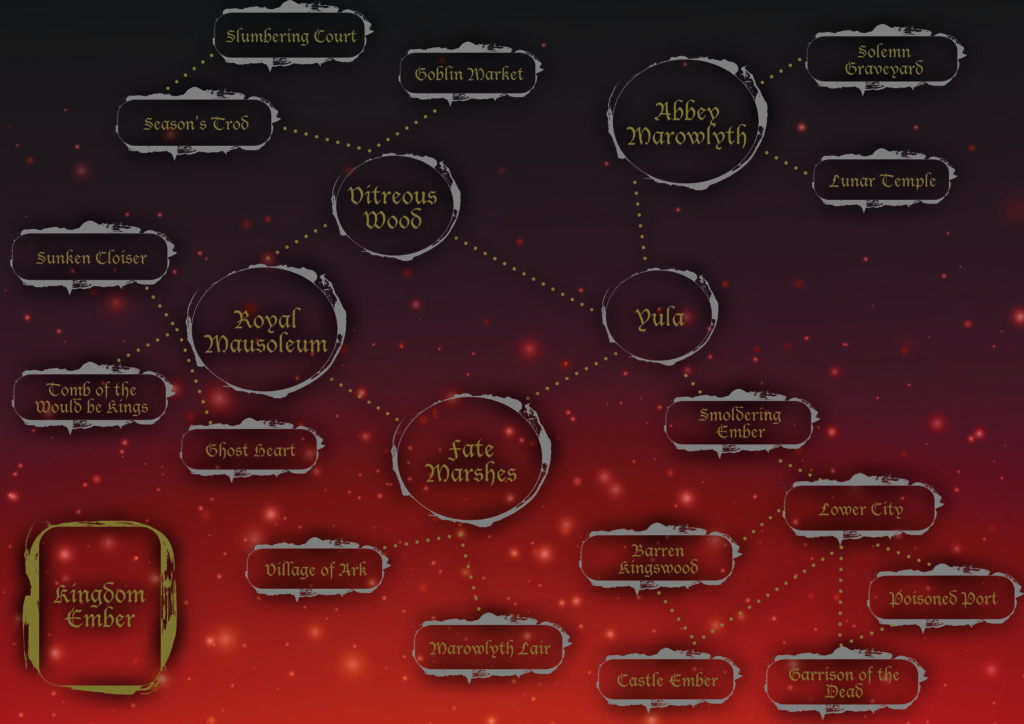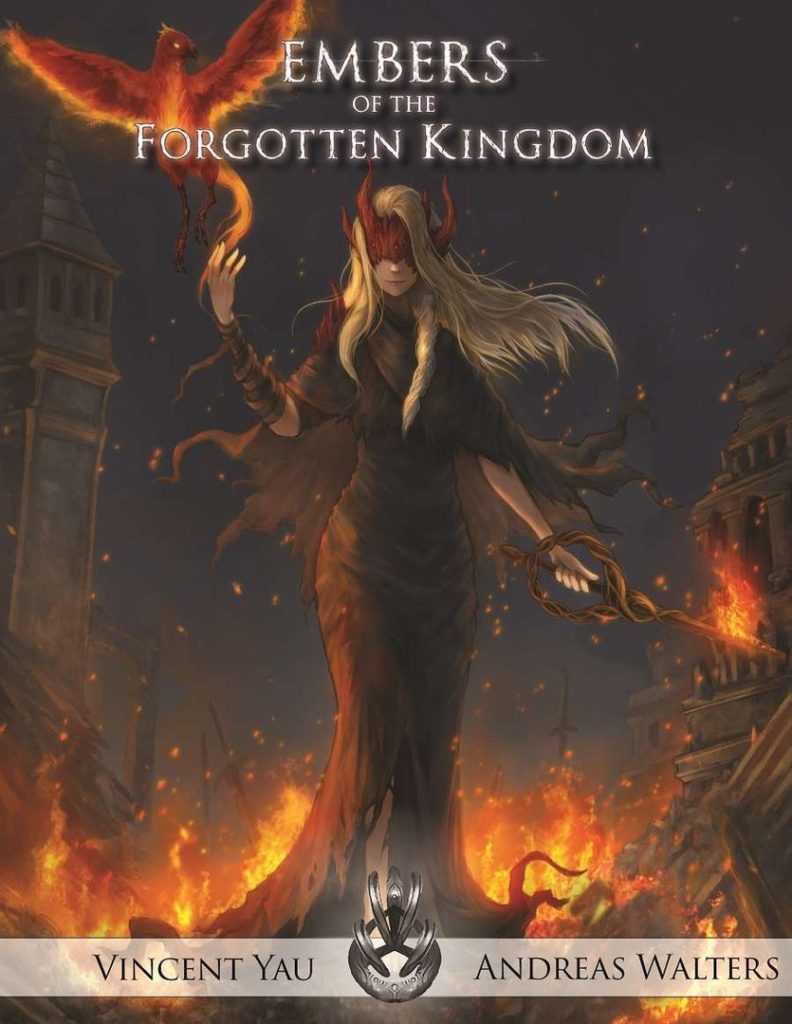Review of Embers of the Forgotten Kingdom

This post contains affiliate links, which are marked with a “*” in the name.
In the previous post I described a Soulsborne setting and its aspects using Embers as an example. In this post, I’ll go into more detail about the content and structure of Embers of the Forgotten Kingdom. This sets itself apart from some of the setting books I’ve read so far, and I think it’s a clever approach for a Soulsborne setting. The world is told from the stories of several characters and then fleshed out with massive settings. Through the web of relationships between the characters, the book also offers a strong idea for a campaign centered around the Summer Curse.
- Publisher: Metal Weave Games
- Release Year: 2018
- Language: English
- Pages: 135
- Format: PDF / Print
- Price: 19,99 $ for the PDF (also available at DriveThruRPG*) / 34,99 $ for the Hardcover + PDF or 44,95 $ for the leatherbound Book + PDF at Metal Weave Games
Character-Driven Story
Embers of the Forgotten Kingdom tells the story, even in the book, through the core and major characters of the plot surrounding the summer curse that holds the land in its grip. Other characters are introduced in the individual locations.
Core Characters
The core characters are those who are actively connected with the Summer Curse and have a significant part in its story. Among them are the Summer King, the Queen of Winter, the Reaper of Ash, and the Earl of Aderyn. Through these characters, the origin of the threat, its current offshoots, and the characters’ backgrounds are interwoven with their current state. Thus, the Queen of Winter continues to sleep, but can be sought out for conversation and is even described as a potentially helpful client.
Possible approaches to solving the curse also form around the characters. These characters in the story are also, at the same time, people who should not be greeted carelessly or with the wrong words. However, if you have the knowledge about these characters, you can not only prevent deadly confrontation, but also get powerful support against the other characters if necessary.
Major Characters
The major characters are part of the core characters’ story, but have a rather supporting role in their background. This does not mean that they cannot contribute a considerable part to solving the summer curse. Thus, among the characters are the Last Prince of Summer, the Fatesealer Witch, the Sundered Duke, and the Crystal Sage.
As with the core characters, these characters can be confronted with their humanity and thus freed from their madness. In the style of Dark Souls, they will be able to pass on more information in cryptic form, but also be helpful themselves for healing some of the core characters.
Within the book, however, the structure of the major characters is no different from the core characters. This is more about their part in Embers’ problem. Since the core and major characters are interrelated, you can also wonderfully ignore the Summer Curse. Just spin your own campaign around other aspects of the relationships between the characters.
Structure of the Character Sections
The structure of the characters is very detailed and spans between 2-6 pages per character.
There is a background per character that reveals the person’s actions and motivations from the origin of the tragedy to the current moment. All the information that the players may be able to uncover and use to their advantage.
This is followed by the character’s current motivation. Many also pursue the ending of the summer curse. In what form varies, but it makes the characters seem twisted, but not stupidly evil, thanks to their broken souls.
Since the characters are the key players and Embers is written in a system-neutral way, there is a section on the abilities of the character. For example, the Reaper of Ash can collect souls to transfer them from this world to the next.
If you get into a fight with the character, a short section describes the tactics of the character.
The relationships between the other characters are also presented in each description of a core or major character and explained with their own paragraphs. What is unfortunately missing is a relationship network. This would have been very clever to add to the texts.
Each character also possesses less than a handful of unique equipment, which, similar to abilities, are described in a system-neutral and brief manner. In the case of our Reaper, this is the Shadow Shroud, which allows her to move back and forth between shadows.
The conclusion is formed by the again somewhat longer, but helpful texts about Roleplaying the Character and Using the Character in the Story. These sections provide guidance to the game master on how to portray the character when the player characters encounter them.
Structure of Sites and Sub-Locations
Embers of the Forgotten Kingdom sheds more light on Castle Ember, the Vitreous Wood, Abbey Marowlyth, the Royal Mausoleum, Forlorn Cove, and Fate Marshes.
For our campaign, I created a point crawl as a map, which I use here to show the sites and their sub-locations:

These locations complement well the feel of Soulsborne games. For example, the Royal Mausoleum is described as a huge place of the dead and their rest. On the other hand, inside is also a labyrinth leading to the individual chambers of the local rulers.
The Abbey is reminiscent of the Tower from Demon Souls and, together with the Vitreous Wood, of the Duke’s Archive from Dark Souls. Nevertheless, the Vitreous Wood in particular tells a rather dark fairy tale story. Fairies who are in the service of the Queen of Winter live here, and an ever-changing Goblin Market can also be found in the forest.
Ember Castle is modelled on the frequent castles and crumbling towns of the game series, while in turn, Forlorn Cove has an otherworldly and Lovecraftian feel to it.
I already used the Forlorn Cove in a Dungeons and Dragons campaign as an intermediate level in the Abyss, and it did a good job of picking up on the incomprehensible and gloomy mood.
But Embers also introduces exciting ideas, like the black magic enthusiastic Brachyura. Crab-like creatures who like to discuss black magic and the nature of the universe, come up with esoteric theories, and dislike being interrupted in their thoughts. On their bodies they have noted their theses and rituals, so they have to work in circles with each other to discuss and read them out.
The Sections of the Sites
As with the characters, the locations follow a consistent structure. Ember Castle has the largest portion, 16 pages, and all other locations are described for about 12 pages. As an example we will use the Royal Mausoleum.
The Royal Mausoleum
A low wail echoes from the dark halls of the Royal Mausoleum. Two large steel gates, curved into the symbols of winter and summer, stand ajar. The faint scent of dried flesh and death wafts through their bars, and inside, in the empty halls of forgotten princes and princesses, something yet lives, lurks, scratches, and moans.
Each site of Embers has a section on the history of the place. This is followed by the points of interest of the site, as well as the characters within the site. In the case of the mausoleum, for example, this includes a camp of brigands as well as the chainman. This former knight was shackled in chains and locked in the mausoleum to rot. These characters can also take on a "boss" character from the video game series, but do not necessarily have to be such characters.
Under the Opportunities, plot hooks are described that can lead to the location or can be expanded upon as the content of the location. One of the opportunities for the mausoleum is the revenge from the chain man. These plot hooks could be seen as a quest idea for individual characters’ storylines. But not all opportunities are limited to individual characters, but can also revolve around the location or items within it.
Sub-Locations
After that, the sub-locations of the place already follow. In the same style, background, interesting places, notable characters and opportunities are described here. In the case of the mausoleum, this brings more information about the Sunken Cloister, the Tomb of the Would be Kings, and the Ghost Heart, which are individual sections that make this setting grow into a massive place.
The Book
I own Embers of the Forgotten Kingdom in a leather bound format with gold foil printing. The book is beautiful with glossy paper that highlights the high quality illustrations. The layout is thematically appropriate and not cluttered. Sections are short, concise, and provide an easy structure for re-reading and recalling specific sections.
In the back, the collected 56 characters, not only core and major characters, but also those described within the settings, are broken down into two pages with their page reference, motivation, and in which location they can be found.
Only the stitch binding makes the dangerous appearance of cutting into the first and last pages.
For which system is Embers?
Through the first post, a small chat arose with Andreas, the founder of Metal Weave Games. Additional supplements are still in the works for the following systems:
- Dungeons and Dragons 5e
- Pathfinder 1e (thoughts are on PF 2e too)
- OSR Games
- Cypher System
- Savage Worlds
- Dungeon World
- FATE
- 13th Age
The Shadow of the Demon Lord companion ca be found as a PDF on the homepage or on DriveThruRPG*.
In the companion for Shadow of the Demon Lord, there are new paths. Paths in Shadow of the Demonlord can be compared to small modular classes from Dungeons and Dragons. Also, the stats of the core and major characters are in the work. Each of the core characters also has several phases and tactics in combat. The final part contains stats for possible encounters within the sites. For the price, a useful addition to the book. Gladly such additional volumes will also appear for the other systems. Thus, one can fall back on prefabricated character options and necessary game stats of the characters.
Conclusion
I for one like Embers on several levels. The book strongly describes the world and the drama of the summer curse from a network of relationships. The story to be played is strongly influenced by the stopped cycle. Still, it does not have to be the focus of the campaign. It can also play a subordinate role and rather form the framework.
Furthermore, it seems to me that they really tried to pick up the mood of the Soulsborne games. They did not recreate the games as the Dark Souls RPG by Steamforged seems to try to do in part. The world feels melancholy, hopeless, and decaying, and paints this as an image in its locations. The characters have motivations and intentions to do – in their eyes – the right thing. Still, they offer the potential for a tragic, dark story laced with broken souls and the loss of humanity.
Every game system has its kind of story it wants to tell. Therefore, it seems a smart move that Embers is written in a system-neutral way. The necessary game materials for the system are provided with the supplements. Thus, everyone can decide for themselves whether Dungeons and Dragons or Pathfinder provides the appropriate rules core for this setting.
Even if your favorite system got no supplement, you can probably easily recreate the characters yourself and design them as part of your preparation. There are fewer than 10 core and major characters, and the encounters within the setting can certainly be mapped with creatures from the respective rulebooks.
The book is nicely designed and usefully structured. For someone who wants to play a campaign in a Soulsborne world, but doesn’t want to get stuck on "git gud" hardcore combat, Embers of the Forgotten Kingdom is more than worth a look.









